- Offensive Techniques & Strategies
Off Ball/Helpside Defense
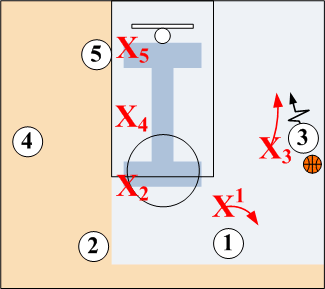
In keeping the ball out of the middle of the court ("Red Zone") by pressuring the ball handler toward a sideline pushpoint, it allows the weakside defenders to sag off their opponents and provide backside support. Helpside support not only eliminates one-on-one isolations, but also provides the defense with a numerical advantage.
Strong backside support, also, allows "On Ball" defenders to become more aggressive and confident by eliminating any fear of getting beat off the dribble. In assuming Helpside "I" positions, defenders are in a position to help out teammates, double team, deny ball cuts, and rotate to the nearest player if/when a trap occurs.
| Backside Support | Helpside Actions | Strike Position | Close Outs | Help the Helper |

Helpside "I"
Providing Strong Backside Support
In assuming a helpside position, the defender must remain alert and active focusing on both the player with the ball and their opponent.
What to Discover or Recall:
Helpside support not only eliminates one-on-one isolations, but also provides the defense with a numerical advantage.
Helpside defenders are responsible for both their opponent and the player with the ball.
Helpside support requires more alertness and effort than guarding a player with the ball. Helpside defense is NOT a place to relax and rest.
Helpside "I" defense requires six basic skills.
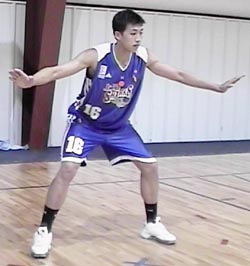
Assume a position between opponent and the ball. Using split vision, seeing both the opponent and the ball.
Maintain a low, aggressive stance pointing one hand at the opponent and the other at the ball.
Stay alert with active feet ready to rotate. Do not stand flat-footed.
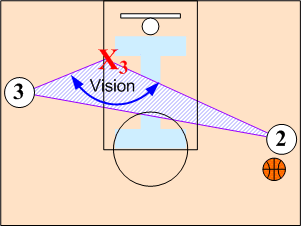
Weakside defenders should play up the passing lane using the same Ball - "You" - Opponent principle as ballside first pass denials. Use split vision, seeing the opponent and the player with the ball.
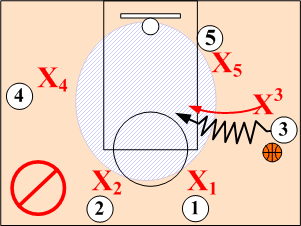
CAUTION
When weakside defenders play close to their opponents, it not only eliminates any defensive help, but also opens up the entire middle area of the court and actually encourages middle penetration.
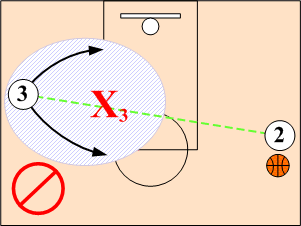
Dictate direction on cuts. Do not give the cutter any options. Helpside defenders should assume a position that forces the opponent to cut in front in order to receive a pass.
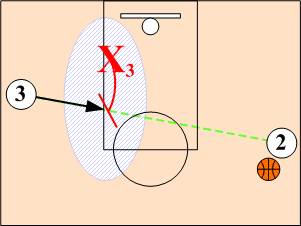
When the opponent does make a cut towards the passer, the defender should step up and physically block the cut.
Inverting
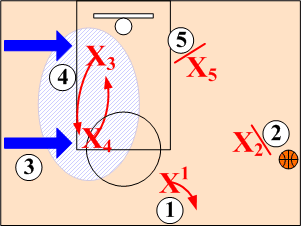
Players in the Helpside I position should recognize when a big player is in a "High I" position and a smaller player is in a "Low I" position, and INVERT by switching positions whenever possible.

Six Basic "Helpside I" Actions
Once in a Helpside I position, defenders can anticipate executing any one of six basic actions: Show & Recover, Taking a Charge, Double teaming, Denying Flash Cuts, Quick Close Outs, and Rebounding (helpside box outs).
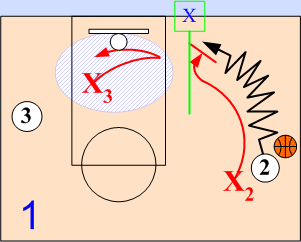
Show and Recover
Step out and Help on dribble penetration. If/when dribbler picks up the ball or reverses direction prior to reaching the baseline pushpoint, recover back to a Helpside I position anticipating a pass.
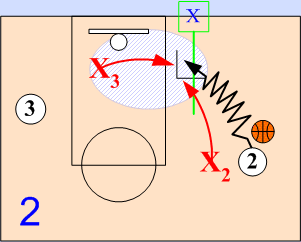
Take a Charge/Double Team
Once the dribbler penetrates beyond the baseline pushpoint extended, the weakside defender should immediately step out and take a charge or double team.
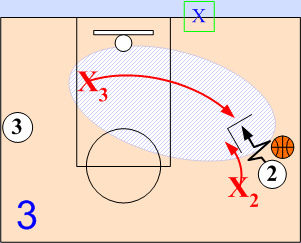
Double Team Early
Whenever a mismatched, one-on-one situation occurs on a wing, the weakside defender should double team the ballhandler early going on the first bounce. Note: Double teaming early option can also be a predetermined action by a coach.
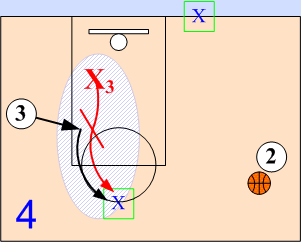
Block Cutters
Aggressively block any direct cut to the ball or basket. Force the cutter to the top of the circle pushpoint. Act (anticipate) rather than react.
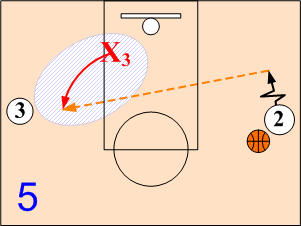
Quick Close Outs
Since almost all passers will telegraph their passes, Helpside defenders should watch the passer's eyes. In addition, cross court passes the passer will "wind up" prior to making the pass providing the Helpside defender ample time to close out and intercept or deflect the pass.
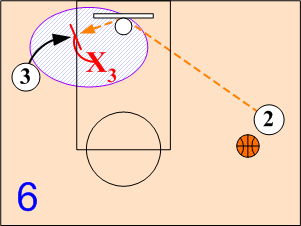
Box Out & Rebound
Assume all shots will be missed and box out opponent. Do not allow any offensive rebounds and second efforts.

The "Strike" Position
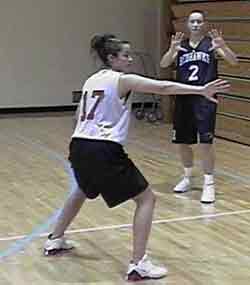
What to Discover or Recall:
,The “Strike” position is the half way position between a pass denial and Helpside support position.
The "Strike" position allows defenders to quickly react to both their opponent's and the ballhandler's actions.
In a "Strike" position, the defender assumes a one step up and one step off the passing lane stance.
Playing Up the Lane
When a defender is located 1 1/2 passes away from the ball or half way between a full pass denial and a helpside I support position, they should assume a "Strike" position one step up and one step off the passing lane. This, "Up" the lane, strike position will allow defenders to quickly react to both their opponent's and the ballhandler's actions.
When a defender is 1 1/2 passes away from the ball, they assume an "Up" (Ball - You - Opponent) pass denial position one step up and one step off the passing lane.
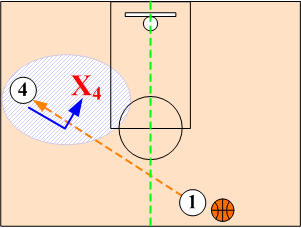
Weakside Wing
Defender plays one step up and one step off the passing lane ready to disrupt any opponent move.
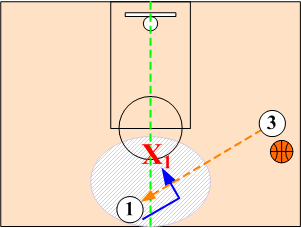
Point
When the ball is on a wing and the offensive point is located toward the helpside of the court, the defender assumes a "Strike" position one step up and one step off the passing lane.
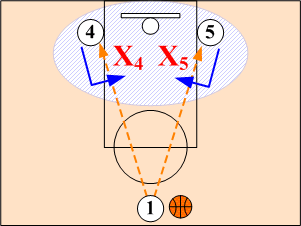
Post
When the ball handler is in the middle of the court (Red Zone), the defenders in the low post area must play one step up and one step off the passing lane in an up the lane Strike position.
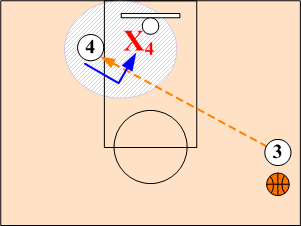
Weakside Post
When the ball is located on the wing, the weakside post defender assumes a Strike position, ready to disrupt any opponent offensive move.
Helpside Defense Printable Version - Click Here

Close Out Rotations
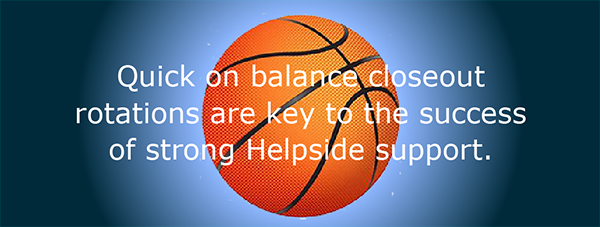
During close outs is when the defense is most vulnerable. Therefore, quick on balance closeout rotations are critical. Every effort should be made to keep the ball on the same side of the court and maintain box pressure. However, when the ball is passed from one side of the court across to the other side, defenders must rotate and quickly matching up against the closest offensive player. Close out rotations must be initiated as the ball leaves the passer's hands.
What to Discover or Recall:
Quick on balance closeout rotations are critical since during close outs is when the defense is most vulnerable.
Helpside defenders must immediately "Close Out" to the nearest opponent moving on pass, not the catch.
Closing out principles are the same for both person to person and zone defenses.
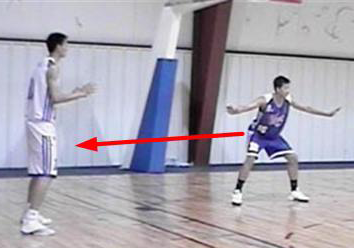
Near Player Rule
As the ball leaves the passers hands, all Helpside defenders must immediately "Close Out" to the nearest opponent moving on pass, not the catch. As ball is in air ("Flight Time"), sprint out and stop on balance using "Chatter Steps."
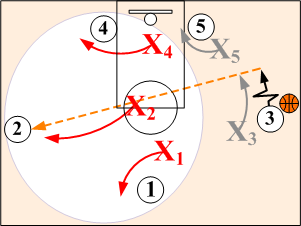
Anticipate the Pass
Since most players telegraph their passes, helpside defenders should watch the passer's eyes. They will tell them where they are going to pass the ball.
Defenders should also capitalize on the fact that most offensive players are poorly skilled in making long or cross court passes.

Closing Out to a Player with the Ball
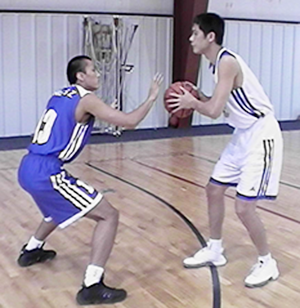
Sprint out quickly directly into a dribble penetration stance. Stay on balance with both hands up in a martial arts position taking away the shot and pass options.
Use small, quick "chatter" steps to stop. Maintain a low "Nose on Chest" position forcing the ballhandler toward a sideline or baseline pushpoint.
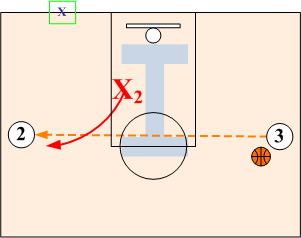
Take away the middle when closing out.
Stay down on balance. Do not try to block the shot or ever run past the shooter.
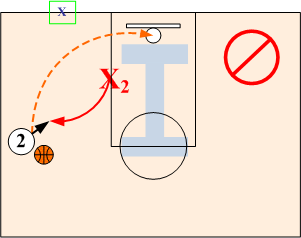
Never Foul a Three Point Shooter
Be aware that on a three point shot, the shooter moves forward and the defender must allow room for them to land.
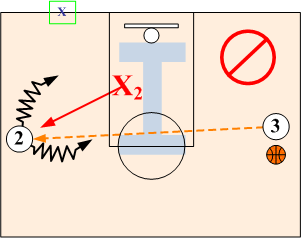
CAUTION: Do not ever run directly at the opponent or leave the ground.
Be extremely alert for the "Pump Fake" shot and drive.

Closing Out to a Player without the Ball
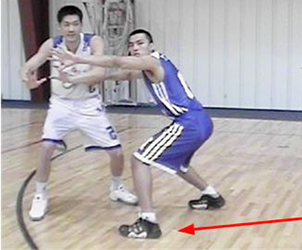
Close out quickly on balance, and aggressively attack the passing lane with near hand and arm extend ("Stop Sign").
Stay low and assume an "Ear on Chest" stance with ball side foot up ready to step first with the foot in the direction your opponent moves.
Caution: In closing out be alert for the back cut option.
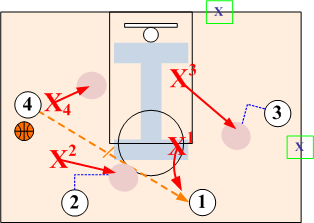
Close out to Support Spots (Not the Opponent)
In playing off and up the lane, it not only puts the defender in position to attack the passing lane, but, also, in a position to close the gap and protect against dribble penetration.
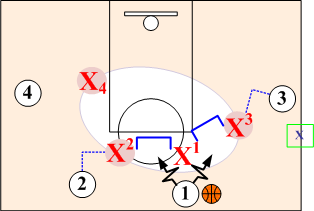
The Illusion of Congestion
In assuming a position off and up the passing lane, it gives the ballhander the illusion of congestion and actually discourages them from driving.
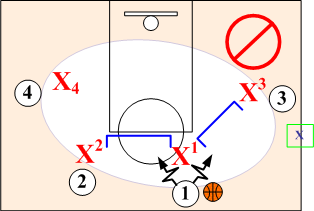
Closing out directly to opponents, not help positions, opens up the middle, but requires the defender to adjust their position.

Ballside Rotations
On ball reversals or skip passes, the ballside players must assume Helpside I positions.
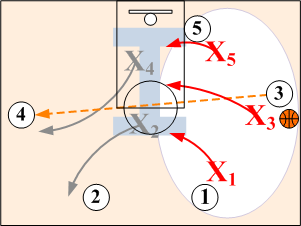
Helpside I Rotations
As the ball leaves the passer's hands, ballside defenders must quickly drop into Helpside I support positions.

Automatic Close Outs
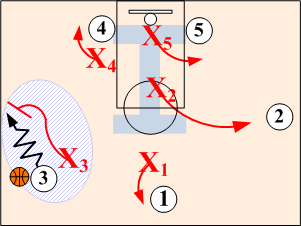
Anytime a dribbler picks up their dribble, the On Ball defender should immediately Jam and smother the ball handler, and all the Off Ball defenders should immediately close out and take away all passing lanes.

“Help the Helper” Rotations
What to Discover or Recall:
“Help the Helper” rotations are also vital for successful traps and double teams.
"Help the Helper" must be active, anticipating passes.
Quick closeouts are also an important element of "Help the Helper" rotations.
Any time a defender gets beat off the dribble, a vital, but often overlooked, part to successful defensive help is the rotation of a third defender. This simultaneous “Help the Helper” rotation is imperative. If a defender is lazy and late on the rotation, it will definitely result in an easy basket for the opponents. Quick closeouts, as the ball leaves the passers hands, are also an important ingredient to the success of help defense. Lazy rotations and closeouts cannot be tolerated.
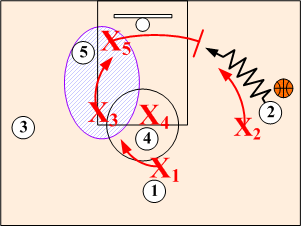
For defensive help to be effective, the weakside defender must step out and help by stopping the dribble penetration outside the “paint” area. At the same time, a third defender must rotate down and help the “Helper.”
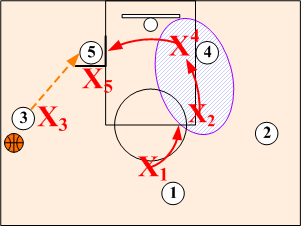
“Help the Helper” rotations are also essential for successful traps and double teams.

In Review
Helpside Support
In providing helpside support, it allows the On Ball defenders to be more aggressive and eliminates the fear of getting beat.
-
Helpside support eliminates one-on-one isolations.
Helpside defenders should assume a low, bent knee stance between the opponent and the ball handler.
Players in the Helpside I position should recognize when a big player is in a "High I" position and a smaller player is in a "Low I" position, and INVERT whenever possible.
Helpside defenders should be ready to execute five different actions: Show & Recover, Double Team, Double Team Early, Block Cutters, and Box Out on shots.
When a defender is located 1 1/2 passes away from the ball or half way between a full pass denial and a helpside I support position, they should assume a "Strike" position one step up and one step off the passing lane.
"Help the Helper" - A vital part to successful defensive help is the rotation of a third defender.
Helpside Close Outs
The ability to close out quickly and effectively is a real key to defensive success.
-
Helpside defenders must close out to the nearest opponent as the ball leaves the passer’s hands.
In closing out to a player with the ball, take away the middle and force to a pushpoint.
Never leave your feet or run pass the shooter.
-
Never foul a three point shooter. Since shooters move forward on three point shots, the defender must leave room for them to land.
Anytime a dribbler picks up their dribble, off ball defenders should immediately close out and take away all of the passing lanes.
Closeouts Printable Version - Click Here

Drills for Skills
Like their offensive counterparts, individual defensive skills must be broken down, practiced and refined on all levels of the game. Select desired drill below to View and/or Print:
For Individual Defensive Drills - Click Here
Return to Player Development - Click Here
Return to Defensive Strategies - Click Here
Return to HoopTactics - Click Here
© 2026 HoopTactics All Rights Reserved.
